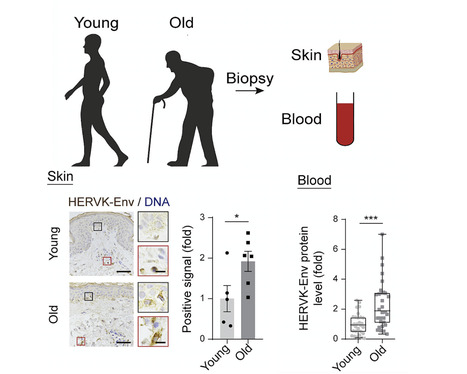Liu and colleagues uncover the ways in which derepression of human endogenous retrovirus triggers cellular senescence and tissue aging; the findings provide fresh insights into therapeutic strategies for alleviating aging.
Summary
Whether and how certain transposable elements with viral origins, such as endogenous retroviruses (ERVs) dormant in our genomes, can become awakened and contribute to the aging process is largely unknown. In human senescent cells, we found that HERVK (HML-2), the most recently integrated human ERVs, are unlocked to transcribe viral genes and produce retrovirus-like particles (RVLPs). These HERVK RVLPs constitute a transmissible message to elicit senescence phenotypes in young cells, which can be blocked by neutralizing antibodies. The activation of ERVs was also observed in organs of aged primates and mice as well as in human tissues and serum from the elderly. Their repression alleviates cellular senescence and tissue degeneration and, to some extent, organismal aging. These findings indicate that the resurrection of ERVs is a hallmark and driving force of cellular senescence and tissue aging.
Highlights
- Derepression of the endogenous retrovirus contributes to programmed aging
- Upregulation of HERVK triggers the innate immune response and cellular senescence
- Extracellular HERVK retrovirus-like particles induce senescence in young cells
- Endogenous retrovirus serves as a potential target to alleviate aging
Published in Cell (Jan. 6, 2023):



 Your new post is loading...
Your new post is loading...







